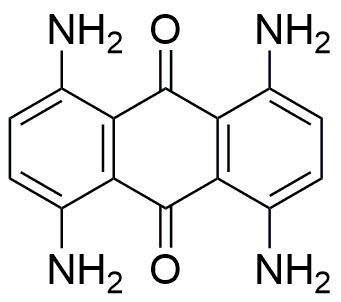Disperse Blue 1 is widely utilized in research focused on:
- Dyeing and Textile Industry: This compound is primarily used as a dye for synthetic fibers, particularly polyester. Its vibrant blue color and excellent lightfastness make it a preferred choice for manufacturers aiming for high-quality textile products.
- Biological Staining: In biological research, Disperse Blue 1 serves as a staining agent for various tissues and cells. It helps in visualizing cellular structures under a microscope, aiding researchers in histological studies.
- Environmental Monitoring: The compound is employed in assessing water quality, as it can indicate the presence of certain pollutants. Its application in environmental science helps in tracking contamination levels in aquatic ecosystems.
- Polymer Industry: Disperse Blue 1 is used in the formulation of colored plastics and coatings. Its stability and compatibility with various polymers enhance the aesthetic appeal and durability of plastic products.
- Research and Development: In chemical research, this dye is utilized to study the interaction of dyes with different substrates, contributing to the development of new materials and applications in the field of nanotechnology.
General Information
Properties
Safety and Regulations
Applications
Disperse Blue 1 is widely utilized in research focused on:
- Dyeing and Textile Industry: This compound is primarily used as a dye for synthetic fibers, particularly polyester. Its vibrant blue color and excellent lightfastness make it a preferred choice for manufacturers aiming for high-quality textile products.
- Biological Staining: In biological research, Disperse Blue 1 serves as a staining agent for various tissues and cells. It helps in visualizing cellular structures under a microscope, aiding researchers in histological studies.
- Environmental Monitoring: The compound is employed in assessing water quality, as it can indicate the presence of certain pollutants. Its application in environmental science helps in tracking contamination levels in aquatic ecosystems.
- Polymer Industry: Disperse Blue 1 is used in the formulation of colored plastics and coatings. Its stability and compatibility with various polymers enhance the aesthetic appeal and durability of plastic products.
- Research and Development: In chemical research, this dye is utilized to study the interaction of dyes with different substrates, contributing to the development of new materials and applications in the field of nanotechnology.
Documents
Safety Data Sheets (SDS)
The SDS provides comprehensive safety information on handling, storage, and disposal of the product.
Product Specification (PS)
The PS provides a comprehensive breakdown of the product’s properties, including chemical composition, physical state, purity, and storage requirements. It also details acceptable quality ranges and the product's intended applications.
Certificates of Analysis (COA)
Search for Certificates of Analysis (COA) by entering the products Lot Number. Lot and Batch Numbers can be found on a product’s label following the words ‘Lot’ or ‘Batch’.
*Catalog Number
*Lot Number
Certificates Of Origin (COO)
This COO confirms the country where the product was manufactured, and also details the materials and components used in it and whether it is derived from natural, synthetic, or other specific sources. This certificate may be required for customs, trade, and regulatory compliance.
*Catalog Number
*Lot Number
Safety Data Sheets (SDS)
The SDS provides comprehensive safety information on handling, storage, and disposal of the product.
DownloadProduct Specification (PS)
The PS provides a comprehensive breakdown of the product’s properties, including chemical composition, physical state, purity, and storage requirements. It also details acceptable quality ranges and the product's intended applications.
DownloadCertificates of Analysis (COA)
Search for Certificates of Analysis (COA) by entering the products Lot Number. Lot and Batch Numbers can be found on a product’s label following the words ‘Lot’ or ‘Batch’.
*Catalog Number
*Lot Number
Certificates Of Origin (COO)
This COO confirms the country where the product was manufactured, and also details the materials and components used in it and whether it is derived from natural, synthetic, or other specific sources. This certificate may be required for customs, trade, and regulatory compliance.


